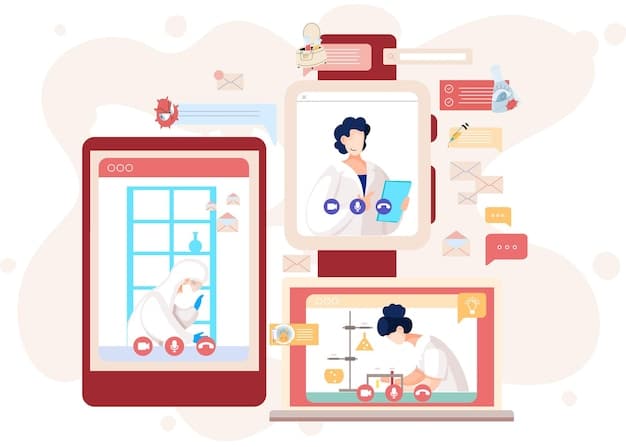Telehealth and AI: Revolutionizing Personalized Healthcare

Telehealth and AI converge to create personalized and predictive healthcare solutions, offering remote monitoring, AI-driven diagnostics, and tailored treatment plans for improved patient outcomes and accessibility.
The convergence of telehealth and AI is rapidly transforming the healthcare landscape, promising a future where personalized and predictive care is not just a possibility but a reality. This synergy unlocks unprecedented opportunities to enhance patient access, improve treatment efficacy, and reduce healthcare costs by leveraging the power of remote monitoring, data analytics, and intelligent algorithms.
The Evolution of Telehealth and AI in Healthcare
Telehealth, or telemedicine, has evolved from a niche service to a mainstream solution, driven by advancements in technology and a growing demand for accessible healthcare. Simultaneously, artificial intelligence (AI) has emerged as a transformative force, capable of analyzing vast amounts of data to identify patterns, predict outcomes, and personalize treatments.
The integration of these two powerful technologies marks a new era in healthcare, where patients can receive timely, accurate, and personalized care, regardless of their location or circumstances.

Key benefits of integrating AI with telehealth
The integration of AI into telehealth has the potential to revolutionize healthcare delivery. Benefits include:
- Enhanced Diagnostic Accuracy: AI algorithms can analyze medical images, interpret lab results, and identify subtle patterns that may be missed by human clinicians, leading to more accurate and timely diagnoses.
- Personalized Treatment Plans: AI can analyze patient data to create tailored treatment plans that optimize outcomes while minimizing potential side effects.
- Remote Patient Monitoring: AI-powered remote monitoring systems can track patients’ vital signs, medication adherence, and activity levels, allowing clinicians to intervene proactively when necessary.
- Improved Patient Engagement: AI-powered virtual assistants can provide patients with personalized education, reminders, and support, improving their engagement in their own care.
These benefits translate into improved patient outcomes, reduced healthcare costs, and a more efficient healthcare system.
In conclusion, the symbiosis of telehealth and AI will continue to reshape the healthcare industry, empowering patients with proactive, tailored, and accessible medical solutions.
Personalized Medicine Through Telehealth and AI
Personalized medicine, or precision medicine, aims to tailor medical treatment to the individual characteristics of each patient. This approach considers factors such as genetics, lifestyle, and environment to optimize treatment effectiveness and minimize adverse effects. Telehealth and AI play a crucial role in enabling this level of personalization.
By leveraging the power of remote monitoring, data analytics, and machine learning, healthcare providers can gain a deeper understanding of each patient’s unique needs and tailor treatment plans accordingly.
How AI enhances telehealth for personalized care
AI algorithms can analyze data collected through telehealth platforms to:
- Predict Patient Risk: Identify patients who are at high risk of developing certain conditions or experiencing adverse events.
- Optimize Medication Dosage: Determine the optimal dosage of medication for each patient based on their individual characteristics.
- Recommend Personalized Interventions: Suggest lifestyle changes, therapies, or other interventions that are most likely to benefit the patient.
- Monitor Treatment Response: Track patients’ response to treatment and make adjustments as needed.

These capabilities enable healthcare providers to deliver more effective and efficient care, leading to improved patient outcomes and lower healthcare costs.
In summary, incorporating AI into telehealth paves the way for personalized medicine, where treatments are designed specifically for each patient’s unique profile, improving health outcomes and reducing unnecessary medical interventions.
Predictive Healthcare: AI’s Role in Early Detection
Predictive healthcare aims to anticipate and prevent health problems before they occur. This proactive approach relies on the analysis of large datasets to identify patterns and predict future health risks. AI is particularly well-suited for this task, thanks to its ability to process vast amounts of data and identify subtle correlations that may be missed by human analysts.
Predictive healthcare can transform the delivery of medical services, moving from reactive treatments to strategic prevention and early intervention.
AI-driven predictive analytics in telehealth
AI algorithms can analyze data collected through telehealth platforms to:
- Predict Disease Outbreaks: Identify areas where there is a high risk of disease outbreaks, allowing public health officials to take preventative measures.
- Predict Hospital Readmissions: Identify patients who are at high risk of being readmitted to the hospital, allowing healthcare providers to provide additional support and prevent readmissions.
- Predict Adverse Drug Reactions: Identify patients who are at high risk of experiencing adverse reactions to certain medications, allowing healthcare providers to choose safer alternatives.
By predicting these outcomes, healthcare providers can take proactive steps to prevent problems before they arise, improving patient outcomes and reducing healthcare costs.
In conclusion, AI’s incorporation into telehealth strategies promotes predictive healthcare, facilitating early detection and preventative management of diseases, leading to better health outcomes for patients.
Challenges and Ethical Considerations
The integration of telehealth and AI raises several challenges and ethical considerations that must be addressed to ensure responsible and equitable implementation. These challenges include data privacy, algorithmic bias, and the potential for job displacement.
Overcoming these challenges is essential to harnessing the full potential of telehealth and AI while safeguarding patient rights and promoting equitable access to care.
Addressing challenges in telehealth and AI
Steps to address the challenges include:
- Data Privacy: Implementing robust data security measures and adhering to privacy regulations such as HIPAA to protect patient data.
- Algorithmic Bias: Ensuring that AI algorithms are trained on diverse datasets and regularly audited to prevent bias and avoid perpetuating health disparities.
- Job Displacement: Providing training and support for healthcare workers who may be displaced by AI, helping them transition to new roles in the evolving healthcare landscape.
Additionally, it is important to engage patients and the public in discussions about the ethical implications of telehealth and AI, ensuring that their concerns are addressed and that their voices are heard.
In summary, addressing the complexities of data privacy, algorithmic bias, and workforce adaptation is crucial for navigating the intersection of telehealth and AI responsibly and ethically.
The Future of Telehealth and AI: Trends and Innovations
The future of telehealth and AI is bright, with numerous trends and innovations poised to transform healthcare delivery. These include the development of more sophisticated AI algorithms, the expansion of telehealth services to new settings, and the integration of wearable devices and remote monitoring technologies.
These advancements promise to make healthcare more accessible, affordable, and personalized than ever before.
Emerging trends and innovations
Emerging trends and innovations include:
- AI-powered Virtual Assistants: Virtual assistants that can provide patients with personalized education, reminders, and support, improving their engagement in their own care.
- Remote Patient Monitoring: Wearable devices and other remote monitoring technologies that can track patients’ vital signs, medication adherence, and activity levels, allowing clinicians to intervene proactively when necessary.
- AI-driven Drug Discovery: AI algorithms that can analyze vast amounts of data to identify new drug targets and accelerate the drug discovery process.
- Telehealth in Rural Areas: Expansion of telehealth services to rural and underserved areas, improving access to care for patients who may have limited options.
These trends and innovations hold the promise of transforming healthcare, making it more accessible, efficient, and effective.
In wrapping up, the ongoing evolution of telehealth and AI promises a future of sophisticated tools and expanded access, enhancing healthcare efficiency and the patient experience.
Regulatory and Policy Considerations
The adoption of telehealth and AI is influenced by an evolving regulatory landscape. Policies are being developed to ensure safety, privacy, and equitable access. Understanding these regulations is critical for providers and developers alike.
Policy frameworks supporting telehealth are essential for promoting innovation and ensuring that these technologies benefit all members of society.
Key regulatory areas
Key regulatory considerations include:
- Data Security and Privacy: Compliance with laws like HIPAA is essential.
- Licensure and Credentialing: Addressing how healthcare providers can practice across state lines.
- Reimbursement Policies: Ensuring that telehealth services are adequately reimbursed by insurance providers.
In response, the policy environment around telehealth is likely to remain flexible and adaptable, reflecting the dynamic nature of the technology itself.
To conclude, adapting to policy directives is crucial for safely and equitably integrating telehealth and AI, assuring benefits reach every segment of society.
| Key Point | Brief Description |
|---|---|
| 🏥 Enhanced Diagnostics | AI improves diagnostic accuracy through advanced image analysis and data interpretation. |
| 🌱 Personalized Treatment | Telehealth, powered by AI, tailors treatments to individual patient needs. |
| 🚨 Predictive Care | AI predicts health risks, enabling proactive interventions in telehealth. |
| 🔒 Ethical Considerations | Addressing data privacy and algorithmic bias is crucial for responsible AI in telehealth. |
Frequently Asked Questions (FAQ)
▼
AI enhances telehealth by improving diagnostic accuracy, personalizing treatment plans, and enabling predictive healthcare through advanced data analysis and machine learning capabilities.
▼
Key challenges include ensuring data privacy and security, addressing algorithmic bias to prevent health disparities, and managing potential job displacement among healthcare workers.
▼
Telehealth and AI personalize treatments by analyzing patient-specific data, predicting individual risks, optimizing medication dosages, and recommending interventions tailored to a patient’s profile.
▼
Future trends include the use of AI-powered virtual assistants, advanced remote patient monitoring through wearables, AI-driven drug discovery, and expanded telehealth services in underserved rural areas.
▼
Important regulatory considerations include compliance with data security and privacy laws like HIPAA, addressing licensure and credentialing for cross-state practice, and establishing reimbursement policies for telehealth services.
Conclusion
The integration of telehealth and AI represents a significant step forward in healthcare, offering the potential to deliver personalized, predictive, and more accessible care. While challenges remain, ongoing innovation and thoughtful regulation will pave the way for a future where healthcare is more effective and patient-centered.





